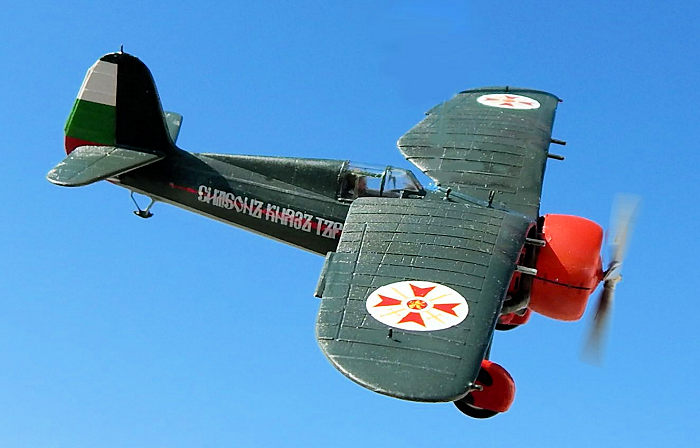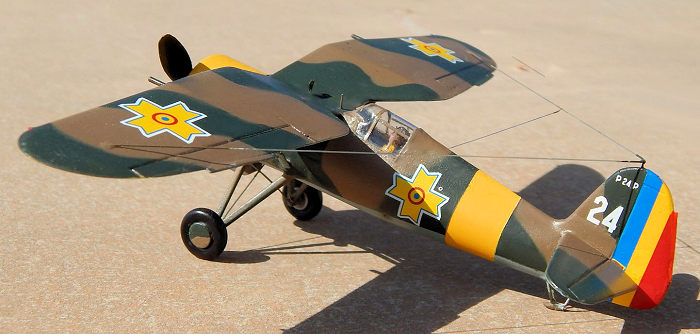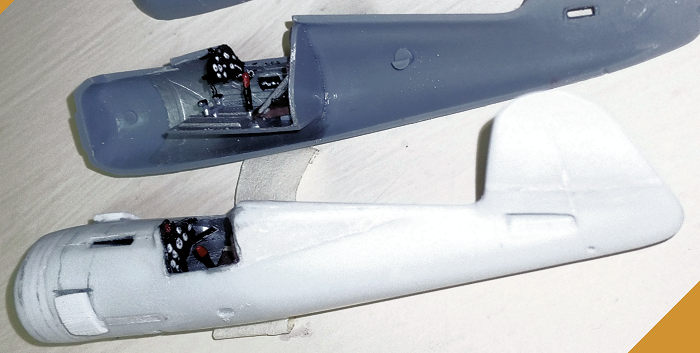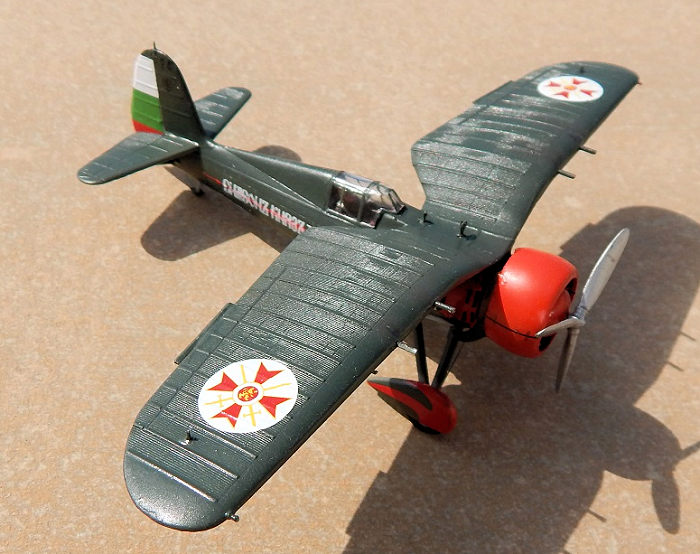
Azur 1/72 PZL P.24B/E
| KIT #: | FR 011 |
| PRICE: | £ |
| DECALS: | Three Options |
| REVIEWER: | Carmel J. Attard |
| NOTES: | Includes photo etch parts |

| HISTORY |
Evolved from the well-known PZL P-11 Polish fighter the P-24 was purchased by four nations among them was Bulgaria that initially acquired 14 of the type. The first P-24B prototype, based on the P.11a and powered by a Gnome Rhone 14kds engine, 760 hp (570 kW) engine, was flown in May 1933. The second P.24/II prototype, named the "Super P.24", set a world speed record for radial engine -powered fighters (414 km/h). The third P.24/III prototype was the "Super P.24bis" with a more powerful 14Kfs engine. The type was shown at the Paris air show in 1934 attracting great interest from the participants.
The aircraft was conventional in layout, with high wings. It was all-metal and metal-covered. The wings had a gull-wing shape, with a thin profile close to the fuselage, to provide a good view for the pilot. This configuration was developed by Zygmunt Pulawski and called "the Polish wing". The canopy was closed (apart from prototype). An internal 360 liter fuel tank in the fuselage could be dropped in case of fire emergency. It had conventional fixed landing gear with a rear skid.
In Bulgarian AF service:-
 In
July 1937 besides the He-51 B-1 exhibited at Sofia-Bojuriste airfield was a
line of PZL P-24B fighters. One of these fighters was dedicated to and named
after Crown Prince Simeon Tarnovski. The PZL P-24Bs Yastreb belonged to the
Bojuriste Training Orliak Fighter Yato, which offered close cover of the
capital Sofia. It was Bulgarian’s most powerful fighter pre-WWII era.
In
July 1937 besides the He-51 B-1 exhibited at Sofia-Bojuriste airfield was a
line of PZL P-24B fighters. One of these fighters was dedicated to and named
after Crown Prince Simeon Tarnovski. The PZL P-24Bs Yastreb belonged to the
Bojuriste Training Orliak Fighter Yato, which offered close cover of the
capital Sofia. It was Bulgarian’s most powerful fighter pre-WWII era.
Bulgarian 12 P.24Bs were divided among three Squadrons (“Yato”), Numbers 1, 2 and 3, with apparently four aircraft per squadron. Bulgaria placed the squadron number on the side of the fuselage in a doubling of the squadron number. So, an aircraft in No. 1 Squadron carried the number 11 on the fuselage, 22 for 2 Squadron and 33 for 3 Squadron. The individual aircraft number was on the fin.
The Bulgarian PZL P-24Bs, which entered operational service in 1938, were fitted with a three-bladed metal propeller, a standard propeller for all the P-24’s other than Romanian version, and were armed with four wing mounted machine guns.
In Romanian service
The Romanians who already operated 50 of the
earlier P-11b and P-11f under licence, decided to acquire the PZL P-25. PZL
supplied the P-24s in October 1936 for the final assembly by IAR in Brastov,
a long
with a licence for them to build 25 additional aircraft. The use of the K-14
engine in the P-24 led to severe vibration problems. The Romanian finally
solved the issue by using a wooden two-bladed airscrew in place of the
intended three bladed metal propeller. They also had to fit a 2/3-reduction
gear to the engine along with a NACA cowling.
long
with a licence for them to build 25 additional aircraft. The use of the K-14
engine in the P-24 led to severe vibration problems. The Romanian finally
solved the issue by using a wooden two-bladed airscrew in place of the
intended three bladed metal propeller. They also had to fit a 2/3-reduction
gear to the engine along with a NACA cowling.
The P-24s entered Romanian service in early 1940. At the beginning of Operation Barbarossa they protected Bucharest and Ploesti oil fields from Soviet bombers. Then from July 1941, the P-24s progressively moved to the Odessa front providing close support to both German and Romanian troops. They also scored some victories when confronted by Soviet fighters. However the Soviet aces Grigoriy Rechkalov, Alexandr Pokryshkin and Ivan Kozhedub (Allied top-scoring Ace) also managed to add some P-24s to their tallies during this period. In early 1942 the 23 surviving P-24s were transferred to training units. Romanian P-24s were armed with two 7.92mm Browning FN machine guns, two grenade-throwers IAR Barbieri with 12 anti-personnel grenades. They aircraft was powered by an IAR K-14 II C32 radial engine developing 870 Hp (Licence –built Gnome & Rhone).
| THE KIT |
 The kit
is molded in gray injected sprues and another clear one for the canopy. It
can be completed in in either a P-24B in Bulgarian service or as a Romanian
P-24E. The 10 page instructions is very well done complete with detailed
drawings as reference. Optional parts are provided to make any of the two
versions. Some rigging was required for the gear legs. Decals were of top
quality and provide for three aircraft. One is a pre-war Bulgarian version
that has a long red speed trim and red cowling, camouflaged in Dark green
upper over light blue. Option caters for two Romanian aircraft in dark green
and dark earth camouflage over light blue. An
in detail
build can be referred to which is a similar Azur
kit made by Scott Van Aken.
The kit
is molded in gray injected sprues and another clear one for the canopy. It
can be completed in in either a P-24B in Bulgarian service or as a Romanian
P-24E. The 10 page instructions is very well done complete with detailed
drawings as reference. Optional parts are provided to make any of the two
versions. Some rigging was required for the gear legs. Decals were of top
quality and provide for three aircraft. One is a pre-war Bulgarian version
that has a long red speed trim and red cowling, camouflaged in Dark green
upper over light blue. Option caters for two Romanian aircraft in dark green
and dark earth camouflage over light blue. An
in detail
build can be referred to which is a similar Azur
kit made by Scott Van Aken.
I have used the kit decals except for the fuselage side inscription in white that was gently printed for me by Peter Yanachkov from Illinois and it represents a machine in markings during the inauguration of the first P-24s in Bulgarian service. Thanks to Robert Shoop of Colorado Springs for sending the kit to me.
| CONSTRUCTION |
The 1/72 scale kit of the PZL P-11 by the Polish manufacturer PZW 72 that comes in white styrene and with three different markings of the type in Polish service was used for this conversion. I had two models of this attractive fighter, one was built OOB and the other was used for this conversion and at the same time utilising the extra parts and choice of Romanian decals that comes with the Azur kit of the P-24.
 The kit
comes with rather thick attachments to the sprue but quality was good and the
flash present was of a minor nature. Cockpit is bare with no floor; no control
stick and the seat provided had no pronounced headrest on the fuselage.
The kit
comes with rather thick attachments to the sprue but quality was good and the
flash present was of a minor nature. Cockpit is bare with no floor; no control
stick and the seat provided had no pronounced headrest on the fuselage.
Major parts particularly the fuselage and wings were separated from the sprue and ready for the required alteration. The missing floor, stick, rudder pedals, instrument panel and a crew figure were all prepared but added at a later stage. The fine detail on wings is well defined and great care was taken to preserve it making use of masking tape. From the Azur kit came the extra parts needed for a P-24C and these mainly were a two-bladed propeller, wheels, a deeper cowling and the use of a closed cockpit canopy as well a decals.
The following is a list of the alterations made to
the kit. At a point 1” from the cockpit the forward fuselage was increased by a
¼” distance piece round in shape and of same section as that of the fuselage.
The tail fin and rudder were cut horizontally and extended with a plastic card
distance piece 1/8” wide, Cockpit area on fuselage was cut so that the spare
canopy from the Azur kit will fit properly
 and the
dorsal area was built up with filler. Radiator was removed from the starboard
side and one added to both sides at a place further forward. A narrow taper
wedge made from plastic card was glued to trailing edge to increase the wing
area for the P-24. Machine guns on sides of nose area were blanked using
filler., and mid wing section was reshaped to same design as the Bulgarian P-24
kit. Other details as the engine manifold were shaped from scrap plastic and
added at rear of engine cowling. The joining line at fuselage and tail fin
extension were smoothened with a small amount of filler and sanded to required
finish.
and the
dorsal area was built up with filler. Radiator was removed from the starboard
side and one added to both sides at a place further forward. A narrow taper
wedge made from plastic card was glued to trailing edge to increase the wing
area for the P-24. Machine guns on sides of nose area were blanked using
filler., and mid wing section was reshaped to same design as the Bulgarian P-24
kit. Other details as the engine manifold were shaped from scrap plastic and
added at rear of engine cowling. The joining line at fuselage and tail fin
extension were smoothened with a small amount of filler and sanded to required
finish.
The rest of assembly went according to Azur kit instructions and the model was built as the type based at Pipera airfield (Bucharest) attached to No 62 Squadron in September 1941. This was finished in dark green and dark earth upper surfaces and light blue undersides.
| CONCLUSIONS |
When I am attracted by a particular color scheme such as the Romanian P-24 I enjoy kit bashing and at the same time making best use of surplus accurate kit parts and use of some redundant kit that had been among kits unbuilt for a while waiting for some similar opportunity. End result was very satisfying and I hope modelers out there will be encouraged to revive old kits by treating and utilising them in similar way I did.
16 February 2017
Copyright ModelingMadness.com
If you would like your product reviewed fairly and fairly quickly, please contact the editor or see other details in the Note to Contributors.
Back to the Main Page Back to the Review Index Page Back to the Previews Index Page